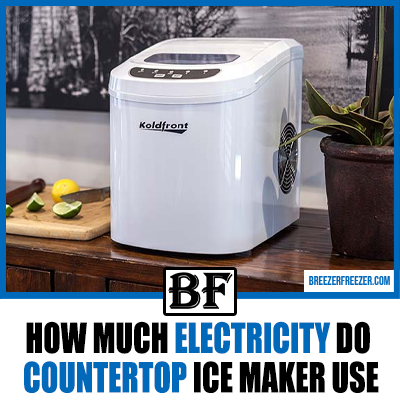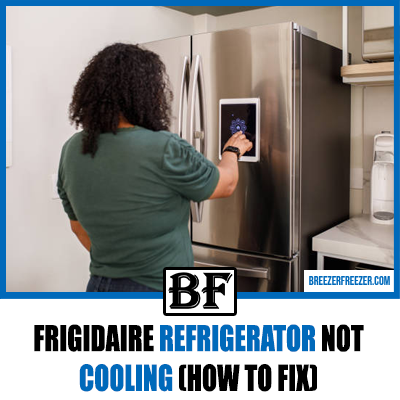Samsung Refrigerator Not Making Ice
The ice maker is undoubtedly an essential feature in a modern Samsung refrigerator. After all, it lets you enjoy ice whenever you want.
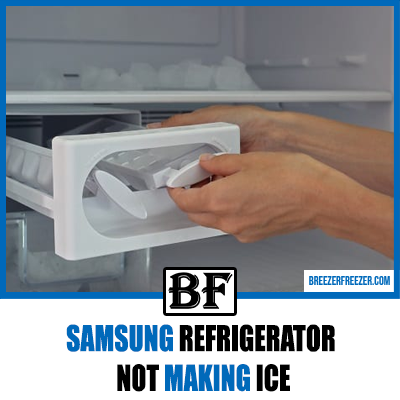
However, like other electronic appliances, refrigerators with ice makers can stop working because of various reasons. But don’t worry yet — most of the underlying issues are fairly easy to fix. Moreover, you could even diagnose and remedy the malfunctioning Samsung refrigerator ice maker yourself before shelling out money for repairs.
That said, we have discussed the possible causes of a faulty Samsung ice maker and what you can do to repair it. Now, without any further ado, let’s get straight into the details.
What To Do When Your Samsung Refrigerator Stops Making Any Ice?
Here is what you need to do when your Samsung refrigerator stops making ice:
1. Check The Water Supply Line
In order to find out what is wrong with your refrigerator, you need to check the water supply line. But first, disconnect the refrigerator from the power source and move it away from the wall. Now, you must be able to see the supply line (a white hose). Check if there is water frozen inside it.
If there is, we recommend turning the water valve off and pouring some hot water onto the supply line to melt the frozen water. Other than that, you could leave the fridge disconnected for about a couple of hours to allow the frozen water line to return to its normal state.
2. Make Sure The Ice Maker Is On
You would want to make sure that the refrigerator ice maker is switched on. To know how to switch it on, refer to the user manual as the process differs from model to model.
3. Take A Look At The Ice Bucket
Take out the ice bucket and check if there is ice in it. If you notice that the ice is fused to the bucket or clumping, that should explain why the refrigerator is not dispensing it.
Additionally, we suggest looking at the hole of the dispenser to check if some ice pieces are blocking it. In such a case, pour hot water through the hole. Then, put the ice bucket back in place. While putting it back, make sure that the bucket sits perfectly in place; otherwise, the ice maker won’t be able to put ice into it.
4. Inspect The Water Pressure
Try dispensing about 3/4 of a cup in 10 seconds to inspect the water pressure of the dispenser. If you are successful, it is safe to assume that the water pressure is adequate. However, if you can’t, remove the water filter and repeat the step. Note that the filter is most likely clogged if the pressure increases. That said, you will have to replace it with a new one that is suitable for Samsung refrigerators.
5. Test Or Reset The Ice Maker
In order to get to the button for resetting the Samsung refrigerator ice maker, you will need to take the ice tray out. Upon finding the button, press and hold it for about 10 seconds. This is going to reactivate the ice maker. Then, all you need to do is wait for 24 hours to let the refrigerator start making ice again.
Why Is Your Refrigerator Not Making Ice?
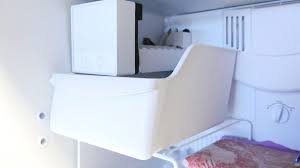
In this section, we have mentioned a few possible reasons your Samsung refrigerator is failing to make ice:
1. Faulty Ice Maker
Test the main ice maker components to find out if it is defective. If all the components work fine and yet, the ice maker fails to produce ice, then you have to get the entire ice maker replaced.
2. Insufficient Water Pressure
As mentioned before, if you can’t fill 3/4 of a glass in about 10 seconds, it means that the water pressure is insufficient. That said, you should take out the filter and try filling the cup again. If you still can’t, consider replacing the filter.
3. Faulty Water Filter
As a rule of thumb, the water filter should be replaced every six months. If it’s been over six months and you haven’t replaced the water filter, we strongly recommend replacing it soon; otherwise, your Samsung refrigerator won’t be able to make any ice. Needless to say, the replacement part should be compatible with a Samsung refrigerator.
4. Frozen Water Line
Another reason your Samsung refrigerator is not making ice is perhaps due to a frozen water line. Here, you can melt the ice in the supply line by pouring hot water over it. Alternatively, we suggest unplugging your refrigerator and letting it sit for one to two hours.
5. Improperly Placed Or Full Ice Bucket
If you don’t dispense the ice when the ice bin is full, the Samsung refrigerator ice maker will stop ice production. So, make sure that you dispense the ice daily if you want the ice maker to make more ice.
Alternatively, you can switch the ice maker off if you don’t need a fresh supply of ice daily. Switch it on only when you need to use it, as keeping it on all the time can damage the ice maker.
Moreover, an ice bucket that is not properly placed may affect ice production, so consider removing and reinserting it. Here, you can take a look at the user manual for the right way to install the ice bucket.
The bottom line is that you want the bucket to sit perfectly in place, allowing the ice to drop into it.
6. The Ice Mold Is Clogged
Often, the ice maker basket gets clogged with ice chunks. And if an entire batch of ice gets stuck in the basket, fresh ice cannot be made. What’s more, the waterline may be affected in the process.
7. Improper Freezer Temperature
If the freezer is set to a lower temperature, the ice maker will freeze up and produce smaller ice cubes. So, you would want to make sure that the freezer temperature is set accordingly.
Another reason your ice maker may not be making enough ice is that the freezer is not sufficiently cold. Needless to say, with a higher refrigerator temperature, the freezer will become warm and cause the ice to melt.
On that note, the ideal freezer temperature recommended for Samsung fridges is between -2 and 0 degrees Fahrenheit. So, keep the freezer at an optimal range to ensure enough ice production.
American Samsung Refrigerator Ice Maker Not Making Enough Ice
The ice maker in a Samsung refrigerator is a useful feature that allows for easy access to ice. However, if it is not making enough ice, there are a few things that could be causing the problem.
One possible issue is that the ice maker’s water supply is not connected or working properly. Make sure that the water supply line is properly connected and that there are no kinks or bends in the line that could be blocking the flow of water. Additionally, check the water filter to ensure it is not clogged and needs to be replaced.
Another issue could be that the ice maker’s temperature is too warm. Make sure that the refrigerator is set to the proper temperature and that the room the refrigerator is in is not too warm. Additionally, check the door seals to ensure that they are tight and not allowing warm air into the refrigerator. If none of these solutions work, contact a professional for assistance.
Frequently Asked Questions (FAQs)
Here, we have answered some commonly asked questions to help clear your queries about Samsung refrigerators.
How does a Samsung freezer make ice?
Your Samsung freezer is fitted with an ice maker to produce ice automatically. A timer lets the water inlet valve know when to open and let the water fill the ice mold. That said, the valve stays open for a few seconds and then closes.
It is worth noting that it is the freezer temperature and not the ice maker that helps freeze the water in the mold. Therefore, it is crucial to keep the temperature settings adequately low to get the best results.
The ice maker features a built-in thermostat that recognizes frozen water, and then it informs the heating coil under the mold to heat the bottom. That way, it lets out the ice stuck to the mold body. Lastly, ejector blades in the ice maker help eject the ice cubes into the ice bucket.
When does a Samsung refrigerator know that it has to stop making ice?
When the optical sensor realizes that the bucket is full, it stops the ice production until the bucket is empty again. Alternatively, when it realizes the bucket is empty, it signals the ice maker to carry out another ice production cycle.
How long does it take for a Samsung refrigerator to make ice?
It takes about 90 minutes for a Samsung refrigerator to make one tray of ice. However, if your fridge is new, it might take a little longer as a new unit requires between 6 and 12 hours to make consumable ice.
Why is my Samsung ice maker not making ice after a filter change?
If your Samsung ice maker is failing to make ice despite a filter change, then there is a high chance that the filter has not been installed properly. If it’s loose, get it fixed as soon as possible; otherwise, it can damage other parts of the fridge, including the electronic control board, pressure sensor, and the main pump.
Why is my Samsung ice maker not getting filled with water to make ice?
If your Samsung ice maker is not getting filled with water to make ice, we suggest taking a look at the water inlet valve. That said, the valve opens to let water into the ice mold, which then freezes. So, if your ice maker doesn’t have any water in it, the chances are that the water pressure is inadequate for the valve to open.
Also, check the water pressure; make sure that it is at least 20 PSI, as anything lower won’t allow the valve to function properly.
How long do Samsung fridges last?
On average, Samsung fridges last for about 15 years. While it can last longer, you might start facing a number of issues, such as a malfunctioning ice maker, uneven temperature, loud noises, misaligned doors, and water leakage.
In most Samsung refrigerator models, the reset button is located in the front of the ice maker.
Samsung Fixes:
- How To Reset Your Samsung Refrigerator
- How To Clean A Samsung Refrigerator Drawer
- How To Remove A Samsung Freezer Drawer
- Fix The Fan Noise On A Samsung Refrigerator
- Samsung Freezer Not Working (Quick Fix)
- Samsung Freezer Not Freezing
- How To Fix Samsung Refrigerator That Is Not Cooling
- How To Add Apps To A Samsung Refrigerator
- How To Turn Off A Samsung Refrigerator
- How To Reset The Filter Light On Your Samsung Refrigerator
- How To Fix A Samsung Refrigerator Ice Maker Jams
- Samsung Refrigerator Freezing Up
- How To Remove A Samsung Ice Maker
- Samsung Ice Maker Noise (How To Fix)
- Samsung Ice Maker Won’t Come Out
- How to Turn a Samsung Ice Maker On and Off
- Samsung Ice Maker Keeps Freezing Up
- How Do I Defrost My Samsung Ice Maker
Final Thoughts
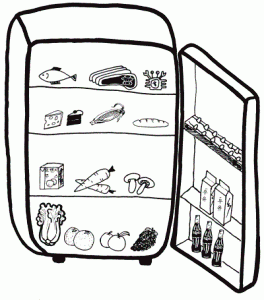
With that, we have reached the end of our informative guide. And we hope that it has helped you figure out why your Samsung refrigerator is not making ice.
If your fridge doesn’t make ice even after you have tried the tips that we mentioned in the guide, we strongly recommend contacting Samsung customer support. You can then file a complaint and request repair services to diagnose and resolve the issue. Plus, if your refrigerator is under warranty, you won’t have to pay a single dollar for repairs.
That’s all for today. Until next time, take care.
![Brand New Fridge Making Noise? [17 Causes & Fixes!]](https://breezerfreezer.com/wp-content/uploads/2023/10/Brand-New-Fridge-Making-Noise.png)


